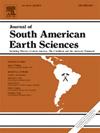The influence of the structural framework on the sedimentation of the Maracangalha Formation in the southern compartment of the Recôncavo Basin
IF 1.7
4区 地球科学
Q3 GEOSCIENCES, MULTIDISCIPLINARY
引用次数: 0
Abstract
Sandy reservoirs formed by lacustrine gravity flows provide important insights into tectono-sedimentary processes associated with syn-sedimentary deformation, which is primarily controlled by tectonic structures that shape the lake-bottom relief. In the Recôncavo Basin, gravity-flow deposits within the Maracangalha Formation constitute significant gas reservoirs. However, their discontinuous and heterogeneous geometries pose challenges for predicting reservoir quality and hydrocarbon volume. The Maracangalha Formation represents a stratigraphic sequence deposited in a deep lacustrine environment during the syn-rift tectonic phase. Intense extensional tectonics, coupled with mud diapirism, generated earthquakes and gravitational destabilization of delta fronts, thereby triggering sandy-muddy gravity flows and their associated deposits. Additionally, syn-sedimentary deformational structures formed by gravity flows, along with subsequent liquefaction and fluidization processes, provide valuable evidence for reconstructing the dynamics and directions of these processes in the study area. A total of ten syn-depositional and late-to post-depositional lithofacies were identified in outcrops within the southern compartment of the Recôncavo Basin, including previously unpublished exposures on several islands in Todos os Santos Bay. These islands include Fontes Island, Bimbarras Island, the neighborhood of Santo Estevão – São Francisco do Conde City, Maria Guarda Island, Vacas Island, Bom Jesus dos Passos Island, and the northern portion of Maré Island. Tilting of depositional surfaces is observed across all sectors due to oblique displacement along extensional faults, with slip magnitude increasing southward. Analysis of syn-depositional sedimentary structures and late-to post-depositional deformational features suggests that sediment gravity flows were predominantly directed southward, with secondary variations toward the southeast, southwest, and west. The transport and deposition of these flows were controlled by a graben–horst system, likely characterized by a southward-dipping ramp geometry, bounded from northwest to southeast by the east-dipping Nova América, west-dipping São Domingos, and east-dipping Candeias faults. Additional controls were exerted by local depocenters associated with the hanging-wall blocks of the Capimirim and Lamarão faults.
构造格架对Recôncavo盆地南隔室Maracangalha组沉积的影响
湖泊重力流形成的砂质储层为研究与同沉积变形相关的构造-沉积过程提供了重要见解,同沉积变形主要受形成湖底起伏的构造构造控制。在Recôncavo盆地,Maracangalha组内的重力流沉积构成了重要的气藏。然而,它们的不连续和非均质几何形状给预测储层质量和油气体积带来了挑战。马拉干加尔哈组是同裂谷构造时期沉积于深湖环境的层序。强烈的伸展构造,加上泥底辟作用,产生了地震和三角洲前缘的重力不稳定,从而引发了砂泥重力流及其伴生矿床。此外,重力流形成的同沉积变形构造及其随后的液化和流化过程为重建研究区重力流作用的动力学和方向提供了有价值的证据。在Recôncavo盆地南部隔室的露头中,共发现了10种同沉积和晚至后沉积岩相,包括以前未发表的Todos os Santos湾几个岛屿上的暴露岩相。这些岛屿包括丰特斯岛、宾巴拉斯岛、圣埃斯特ev o - s o Francisco do Conde城、玛丽亚瓜尔达岛、Vacas岛、Bom Jesus dos Passos岛和mar岛的北部。由于沿伸展断层的斜移,所有扇区的沉积面都发生倾斜,向南的滑动幅度增大。同沉积期沉积构造及沉积后期变形特征分析表明,沉积物重力流以南向为主,次向东南、西南、西方向变化。这些流动的搬运和沉积受地堑-地体体系控制,其特征可能是一个向南倾斜的斜坡几何形状,由西北到东南为东倾的Nova amacimica、西倾的sdomingo和东倾的Candeias断裂所围合。与Capimirim和lamar断层的上盘块体相关的局部沉积中心施加了额外的控制作用。
本文章由计算机程序翻译,如有差异,请以英文原文为准。
求助全文
约1分钟内获得全文
求助全文
来源期刊

Journal of South American Earth Sciences
地学-地球科学综合
CiteScore
3.70
自引率
22.20%
发文量
364
审稿时长
6-12 weeks
期刊介绍:
Papers must have a regional appeal and should present work of more than local significance. Research papers dealing with the regional geology of South American cratons and mobile belts, within the following research fields:
-Economic geology, metallogenesis and hydrocarbon genesis and reservoirs.
-Geophysics, geochemistry, volcanology, igneous and metamorphic petrology.
-Tectonics, neo- and seismotectonics and geodynamic modeling.
-Geomorphology, geological hazards, environmental geology, climate change in America and Antarctica, and soil research.
-Stratigraphy, sedimentology, structure and basin evolution.
-Paleontology, paleoecology, paleoclimatology and Quaternary geology.
New developments in already established regional projects and new initiatives dealing with the geology of the continent will be summarized and presented on a regular basis. Short notes, discussions, book reviews and conference and workshop reports will also be included when relevant.
 求助内容:
求助内容: 应助结果提醒方式:
应助结果提醒方式:


